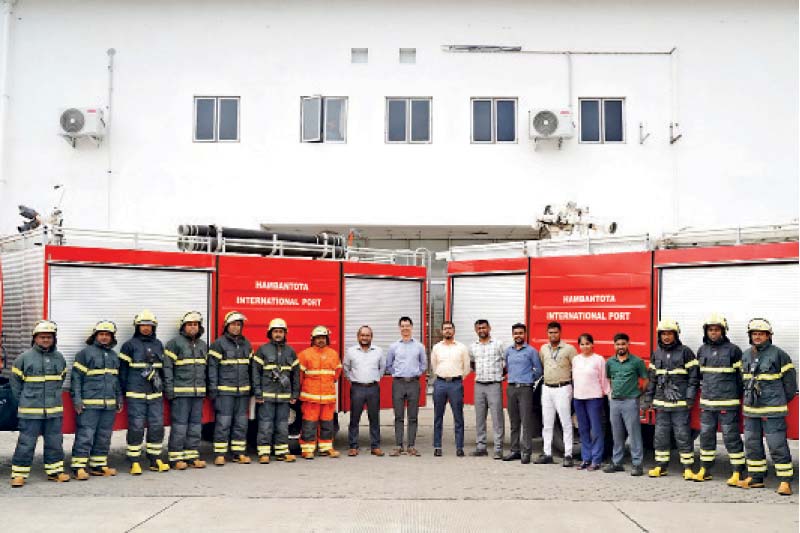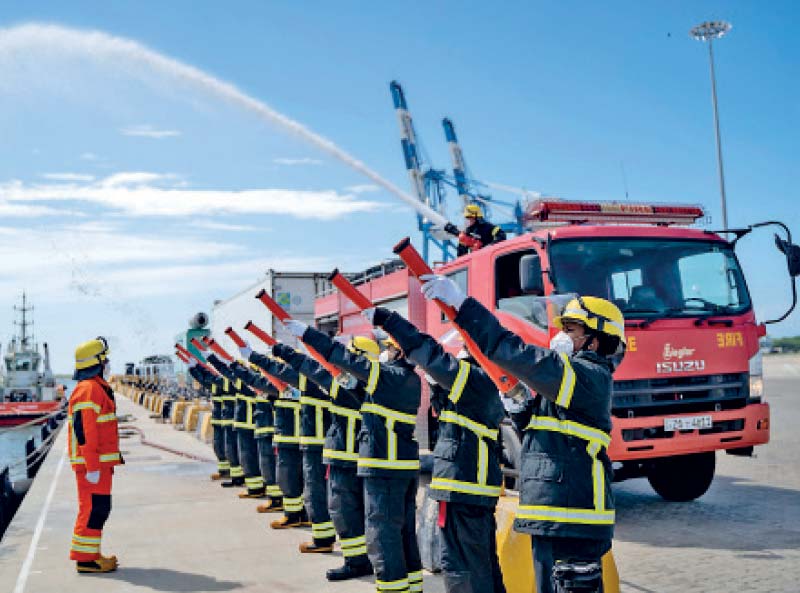Saturday Oct 25, 2025
Saturday Oct 25, 2025
Friday, 15 August 2025 14:14 - - {{hitsCtrl.values.hits}}

Hambantota International Port’s Health & Safety Team with the Emergency Response Unit (ERU). Also in the picture are HIPG’s COO, Tommy Yang, and HIPS General Manager, Capt. Miyuru Gunasekara, Senior Manager - QHSE, Rohan Sanjeewa
At a time when environmental responsibility and workplace safety are critical to the logistics sector, Hambantota International Port (HIP) has set a new standard, becoming the first port in Sri Lanka and South Asia to earn triple ISO certification.
The facility now holds ISO 9001 for quality management, ISO 14001 for environmental management, and ISO 45001 for occupational health and safety; a rare trifecta that reflects more than just compliance. It signals a holistic commitment to sustainability, operational excellence, and the well-being of its workforce.
Safety at Hambantota International Port begins long before anyone sets foot inside the facility.
Every individual, be it visitor, employee, or contractor, is required to complete mandatory safety induction training. The Security and Safety department ensures that all personnel complete related training and familiarisation sessions before entry, reinforcing a culture of prevention over reaction. Beyond the gate, a strict work permit system mandates risk assessments for all tasks, whether hot work, confined spaces, construction, or height-related activities. Specialised supervisors and the 24-hour health and safety team review each task and its environmental impact to identify and mitigate risks before work begins.
Environmental Stewardship
Nowhere is HIP’s commitment to environmental excellence more evident than in the pristine condition of its surrounding waters. Recent studies show water quality so high that coral growth has been observed within the harbour, a remarkable testament to the port’s rigorous environmental management practices.
The port operates a state-of-the-art wastewater treatment plant that ensures all discharged water meets stringent national standards. Regular testing and monitoring allow operators to adjust treatment methods as needed, guaranteeing that environmental limits are never exceeded.
This environmental conscientiousness extends to regulatory compliance, with the facility maintaining all required licenses from key authorities, including the Marine Environment Protection Authority (MEPA) and the Central Environmental Authority (CEA). These licenses undergo annual renewal processes, with regular inspections ensuring continued adherence to environmental standards.
The port also submits quarterly and annual compliance reports to the Board of Investment and other regulatory bodies, providing transparent documentation of its environmental performance. This proactive approach to environmental management demonstrates that operational efficiency and ecological responsibility can coexist successfully.
Managing Complex Cargo Operations
Modern ports must handle increasingly diverse and sometimes hazardous cargo, presenting unique challenges for safety and environmental management. HIP has developed comprehensive procedures for managing dangerous goods, implementing strict policies that govern which materials can enter the facility and how they must be handled.
There are dedicated storage areas for dangerous goods and detailed Standard Operating Procedures (SOPs) for each category of hazardous material. Aligned with international maritime safety standards, these protocols ensure that dangerous cargo is managed with the highest level of care throughout loading, storage, and discharge operations.
Any vessel calling at HIP carrying dangerous cargoes must acquire approval’s from Sri Lankan authorities as deemed applicable following standard operating procedures (SOP’s). HIP Operations/Port Control/QHSE & ERU departments will also ensure that such cargo is safely handled in the port adhering to international standards. This multi-layered approval process is designed to prevent potential hazards before they arise.
Emergency Response and Compliance
Even with the most stringent prevention measures in place, ports must be fully prepared for emergencies. Hambantota International Port maintains a specialised Emergency Response Unit (ERU), made up of 36 trained personnel, three modern fire trucks, equipped to handle emergencies such as fires, oil spills, rescue operations, and crises due to extreme weather situations.
The unit follows an annual drill matrix plan, regularly conducting exercises to test and refine its response capabilities across various scenarios. For oil spill incidents specifically, the port is equipped with 800 meters of oil containment boom, as well as dispersants, skimmers, and equipment for various contingencies. The ERU has to date engaged in national level rescue missions such as dousing massive fires that broke at a Hambantota tsunami village, Hambantota town and the Lanwa Cement plant. The ERU was also the first to respond to a mid-sea disaster when the crude oil vessel “MT New Diamond” caught fire off Sri Lanka’s Eastern coast. The Port deployed their best firefighting tugs, MT Ravana and MT Vasabha, equipped with External Fire Fighting capabilities (FIFI).
Emergency preparedness at HIP goes beyond just equipment and training; it includes full regulatory compliance. The port holds annually renewed contingency plan licenses from MEPA, making certain that its emergency response procedures meet national standards and are ready for immediate deployment.
Any non-compliance issues identified during inspections are promptly reported to the relevant departments daily, allowing for swift corrective action. This integrated approach keeps the entire port complex operating as a cohesive unit dedicated to safety and environmental excellence.
Comprehensive Management Structure
Behind Hambantota International Port’s strong safety and environmental management system is a dedicated team of experts, comprising senior managers, Deputy General Managers, and General Managers focused on quality, health, safety and environmental (QHSE) efforts.
The port operates under more than 50 safety and environment procedures and process controls, all rigorously reviewed through annual external audits.These audits independently assess performance across environmental, health, safety, and quality metrics, offering both verification and guidance for continuous improvement. HIP’s safety practices include incentive bonus payments for employees who comply.
A suite of national licenses, from factory inspection certifications to coastal conservation permits, further reinforces regulatory compliance. This framework not only validates the port’s commitment to operational excellence but also ensures accountability to national standards.
Looking Ahead
The port’s success in preserving water quality so pristine that marine life thrives demonstrates that economic growth and environmental stewardship can go hand in hand. As the logistics industry evolves, Hambantota offers a clear roadmap for balancing operational efficiency with environmental responsibility and worker safety.
In an era where all stakeholders demand transparency and accountability, Hambantota International Port has positioned itself not just as a transportation hub but as an industry leader, where safety, environmental protection, and operational excellence come together to build truly sustainable maritime infrastructure.

The Emergency Response Unit (ERU) of Hambantota International Port conducting a routine drill